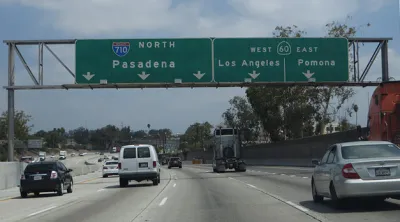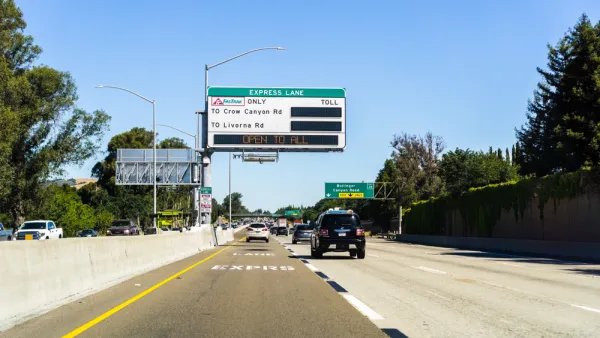That's how the Los Angeles Times editorial board characterized the $6 billion plan by Los Angeles Metro to widen the 710 freeway. "A waste of money," they assert. Key to the solution is how to deal with goods movement from the seaport complex.

"The 710 Freeway is a congested, diesel-polluted mess of a road," begins the Los Angeles Times editorial on Feb. 19. "Built in the 1950s and 1960s, it was never intended to accommodate the endless swarm of vehicles, and particularly trucks, using the freeway today."
The freeway is used by trucks servicing the nation's largest port complex, the ports of Los Angeles and Long Beach, hauling freight "to the sprawling rail yards in Commerce and Vernon east of downtown." Mitigating diesel emissions figures as prominently as mitigating congestion, if not more.
The route carries so many diesel trucks, nearby communities have dubbed the corridor a "diesel death zone" from the concentration of toxic diesel soot and emissions.
The Metropolitan Transportation Authority [Metro] is now looking to update the 710. But despite decades of studies of forward-looking ways to improve congestion and air quality — for example, separating trucks from cars or requiring low-emission trucks — Metro is looking at a solution straight out of the 1950s: Widening the freeway.
Metro staff claims that the project is the most affordable option, comparing it with a $10 billion alternative to build "a four-lane route for low- or no-emission trucks above the existing 710 Freeway." But on the widening, the editorial notes, "[i]t's unlikely that adding two new lanes will make a lasting impact on congestion because of the phenomenon of 'induced demand.'" [Also, see Planetizen, "Lessons in Freeway Widening," August 26, 2017.]
Simply widening the freeway is a missed opportunity and a waste of taxpayer money. If Metro and the California Department of Transportation [Caltrans] want to spend $6 billion on an anachronistic freeway widening, they ought to use the project as a catalyst for cleaning up the freight industry and advancing the plans for a zero-emission port complex.
HOT lanes for trucks?
The editorial board endorses an alternative similar to high occupancy toll (HOT) or express lanes on freeways, where solo-occupied clean air vehicles, as well as carpools, travel toll-free.
The agencies could designate the new road space as truck lanes accessible only to zero-emission trucks. Or they could make them express lanes for big rigs with the toll based on truck emissions. The cleaner the engine, the lower the toll. That could encourage trucking companies to speed up their transition to clean vehicles.
The latter option could prove a challenge. Currently, tolls on express lanes are based only on the level of congestion, and they apply to all vehicles uniformly, except those that are exempt or partially exempt (in some cases, carpools pay a reduced toll rather than being exempt).
The editorial concludes by asserting that "any solution has to guarantee significant cuts to diesel and greenhouse gas emissions and move the region toward a more sustainable cargo-moving industry. The current proposal to widen the freeway doesn't do that. Metro's board of directors shouldn't settle for it."
In a related column in the Times on Feb. 22, architecture critic, Christopher Hawthorne, makes the case that Southern California's freeway-building days are not relegated to the 1950s but very much in the present, citing the 710 widening, the I-405 widening in Orange County which broke ground on Jan. 26, and the High Desert Corridor, a Caltrans proposal to build a freeway connecting the city of Palmdale in Los Angeles County with Victorville in San Bernardino County. It would be Los Angeles County's first new freeway in 25 years, reports Louis Sahagun for the Times on Feb. 10.
FULL STORY: Widening freeways is so 20th century — the 710 Freeway deserves better

Analysis: Cybertruck Fatality Rate Far Exceeds That of Ford Pinto
The Tesla Cybertruck was recalled seven times last year.

National Parks Layoffs Will Cause Communities to Lose Billions
Thousands of essential park workers were laid off this week, just before the busy spring break season.

Retro-silient?: America’s First “Eco-burb,” The Woodlands Turns 50
A master-planned community north of Houston offers lessons on green infrastructure and resilient design, but falls short of its founder’s lofty affordability and walkability goals.

Test News Post 1
This is a summary

Analysis: Cybertruck Fatality Rate Far Exceeds That of Ford Pinto
The Tesla Cybertruck was recalled seven times last year.

Test News Headline 46
Test for the image on the front page.
Urban Design for Planners 1: Software Tools
This six-course series explores essential urban design concepts using open source software and equips planners with the tools they need to participate fully in the urban design process.
Planning for Universal Design
Learn the tools for implementing Universal Design in planning regulations.
EMC Planning Group, Inc.
Planetizen
Planetizen
Mpact (formerly Rail~Volution)
Great Falls Development Authority, Inc.
HUDs Office of Policy Development and Research
NYU Wagner Graduate School of Public Service



























